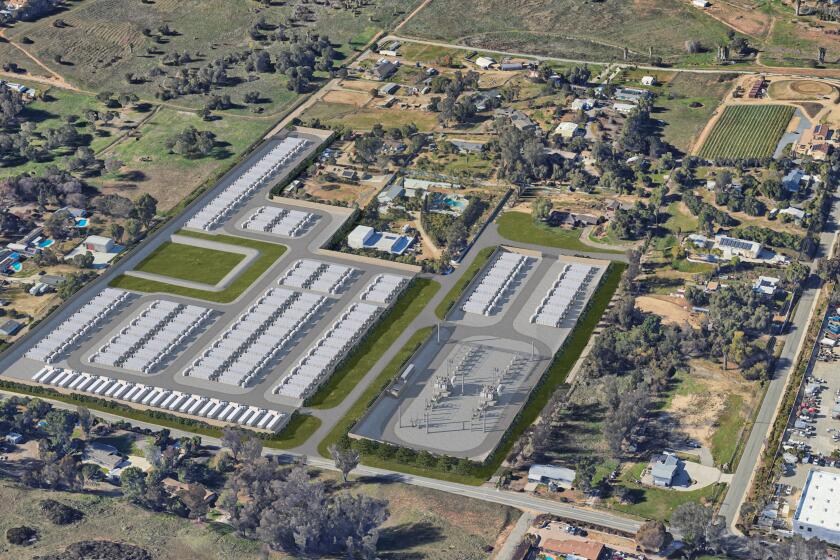ViaSat taking satellite broadband global
Satellite Internet provider ViaSat said Tuesday that it has switched from SpaceX to a French-based rocket firm to launch its ViaSat-2 satellite early next year, and the Carlsbad company unveiled plans for a new constellation of ultra-fast broadband satellites that will be expand its footprint globally.
The firm released a slew of news as part of its fiscal third quarter financial results, which fell slightly short of Wall Street’s estimates on revenue but met expectations for earnings.
The top headline: ViaSat has begun work, in conjunction with Boeing, on two of three planned next-generation satellites, each of which will have more bandwidth than all existing Internet satellites in orbit combined.
ViaSat expects each satellite to have 1 terabyte-per-second network capacity, which could power 100 megabit-per-second Internet service to homes and high definition, video-streaming Wi-Fi on commercial airlines.
Today, ViaSat’s Exede Internet service delivers about 12 megabits-per-second download speeds on average using the company’s first generation, 140 gigabit-per-second satellite launched in 2011. Exede has 687,000 residential subscribers in the U.S. ViaSat also powers high-speed inflight Wi-Fi on 446 domestic commercial aircraft operated by JetBlue, Virgin America and United Airlines.
The first of the three next-generation satellites is expected to launch in 2019, said Chief Executive Mark Dankberg. It will target the Americas. The second satellite is forecast for launch a year later and would focus on Europe, the Middle East and Africa. The timing of the third satellite, which covers Asia/Pacific, hasn’t been determined.
These new satellites would make ViaSat a global provider of broadband Internet service. Today, it operates solely in North America.
“The innovations in the ViaSat-3 system do what until now has been impossible in the telecommunications industry — combining enormous network capacity with global coverage, and dynamic flexibility to allocate resources according to geographic demand,” Dankberg said.
The company estimates the all-in cost of building the first two ViaSat-3 satellites —including launch, insurance and ground equipment — at $1 billion to $1.2 billion, said Dankberg.
Meanwhile, the company plans to launch its second-generation Internet satellite —ViaSat-2 — early next year. Dankberg said the company has inked a deal with Arianespace of France to launch ViaSat-2, replacing a previous contract with Elon Musk’s SpaceX.
A SpaceX Falcon 9 rocket exploded during a test flight in June. That setback has delayed the development schedule for the SpaceX Falcon Heavy rocket that was supposed to launch ViaSat-2.
Switching to Arianespace— the market share leader in satellite launches — will allow the company to hit its target of delivering service on ViaSat-2 in mid-2017. The satellite is expected to have 250 to 300 gigabit-per-second maximum capacity.
“I think Arianespace had a hole in their manifest and we are able to grab it,” ViaSat President Rick Baldridge said in a conference call with analysts. He added that the company will save on insurance by using Arianespace.
ViaSat will use SpaceX to launch one of the three ViaSat-3 satellites at a later date.
Finally, ViaSat has entered into a joint venture in Europe with satellite outfit Eutelsat. The joint venture, which will kick off this year and be 51 percent owned by ViaSat, would sell satellite Internet service to European consumers — similar to ViaSat’s Exede product in the U.S.
Eutelsat will provide the satellite capacity while ViaSat will operate the retail business. That will give the company more than three years of experience in the market ahead of the ViaSat-3 European launch in 2020, Dankberg said.
For its fiscal third quarter, ViaSat reported sales of $348 million, up from $340 million for the same quarter last year. It earned $9.7 million, or 20 cents per share — down from earnings of 31 cents per share a year earlier.
The company blamed the dip in earnings on the wind-down of a satellite equipment contract in Australia and expenses related to building satellites.
The company released results Tuesday after markets closed. Its shares ended trading at $56.90 on the Nasdaq. They climbed 10 cents in early after-hours trading.
Get U-T Business in your inbox on Mondays
Get ready for your week with the week’s top business stories from San Diego and California, in your inbox Monday mornings.
You may occasionally receive promotional content from the San Diego Union-Tribune.










